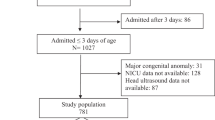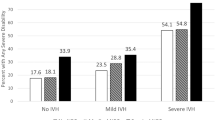Abstract
Objective:
To evaluate the clinical impact of routine term-equivalent magnetic resonance imaging (TE-MRI) for extremely low-birth-weight infants at a regional neonatal intensive care unit.
Study Design:
This is a single-center retrospective study evaluating preterm survivors who underwent TE-MRI. MRI abnormalities were compared between infants with and without cranial ultrasonography (CUS) abnormalities. Cost analysis comparing imaging modalities was also performed.
Results:
TE-MRI use increased from 17% in 2006 to 76% in 2010. MRI detected new findings in nearly half of infants, whether or not they had known ultrasound abnormalities. MRI detected more cerebellar (18% vs 6%, P=0.04) and moderate white matter injury (12% vs 7%, P<0.001), and altered simulated neurological prognosis across developmental domains. The cost of TE-MRI was $1600, which was comparable to serial CUSs.
Conclusion:
TE-MRI detects new abnormalities and impacts developmental prognosis in the extremely low birth weight, which supports its use despite the added financial cost.
This is a preview of subscription content, access via your institution
Access options
Subscribe to this journal
Receive 12 print issues and online access
$259.00 per year
only $21.58 per issue
Buy this article
- Purchase on Springer Link
- Instant access to full article PDF
Prices may be subject to local taxes which are calculated during checkout


Similar content being viewed by others
References
Blencowe H, Cousens S, Oestergaard MZ, Chou D, Moller AB, Narwal R et al. National, regional, and worldwide estimates of preterm birth rates in the year 2010 with time trends since 1990 for selected countries: a systematic analysis and implications. Lancet 2012; 379 (9832): 2162–2172.
Ment LR, Bada HS, Barnes P, Grant PE, Hirtz D, Papile LA et al. Practice parameter: neuroimaging of the neonate: report of the Quality Standards Subcommittee of the American Academy of Neurology and the Practice Committee of the Child Neurology Society. Neurology 2002; 58 (12): 1726–1738.
Maalouf EF, Duggan PJ, Counsell SJ, Rutherford MA, Cowan F, Azzopardi D et al. Comparison of findings on cranial ultrasound and magnetic resonance imaging in preterm infants. Pediatrics 2001; 107 (4): 719–727.
Miall LS, Cornette LG, Tanner SF, Arthur RJ, Levene MI . Posterior fossa abnormalities seen on magnetic resonance brain imaging in a cohort of newborn infants. J Perinatol 2003; 23 (5): 396–403.
Inder TE, Wells SJ, Mogridge NB, Spencer C, Volpe JJ . Defining the nature of the cerebral abnormalities in the premature infant: a qualitative magnetic resonance imaging study. J Pediatr 2003; 143 (2): 171–179.
Kidokoro H, Neil JJ, Inder TE . New MR imaging assessment tool to define brain abnormalities in very preterm infants at term. Am J Neuroradiol 2013; 34 (11): 2208–2214.
Arthur R . Magnetic resonance imaging in preterm infants. Pediatr Radiol 2006; 36 (7): 593–607.
Neubauer V, Griesmaier E, Baumgartner K, Mallouhi A, Keller M, Kiechl-Kohlendorfer U . Feasibility of cerebral MRI in non-sedated preterm-born infants at term-equivalent age: report of a single centre. Acta Paediatr 2011; 100 (12): 1544–1547.
Ho T, Dukhovny D, Zupancic JA, Goldmann DA, Horbar JD, Pursley DM . Choosing wisely in newborn medicine: five opportunities to increase value. Pediatrics 2015; 136 (2): e482–e489.
Mathur AM, Neil JJ, McKinstry RC, Inder TE . Transport, monitoring, and successful brain MR imaging in unsedated neonates. Pediatr Radiol 2008; 38 (3): 260–264.
Woodward LJ, Anderson PJ, Austin NC, Howard K, Inder TE . Neonatal MRI to predict neurodevelopmental outcomes in preterm infants. N Engl J Med 2006; 355 (7): 685–694.
Walsh M, Engle W, Laptook A, Kazzi SN, Buchter S, Rasmussen M et al. Oxygen delivery through nasal cannulae to preterm infants: can practice be improved? Pediatrics 2005; 116 (4): 857–861.
Walsh MC, Kliegman RM . Necrotizing enterocolitis: treatment based on staging criteria. Pediatr Clin North Am 1986; 33 (1): 179–201.
Papile LA, Burstein J, Burstein R, Koffler H . Incidence and evolution of subependymal and intraventricular hemorrhage: a study of infants with birth weights less than 1,500 gm. J Pediatr 1978; 92 (4): 529–534.
Keren R, Luan X, Localio R, Hall M, McLeod L, Dai D et al. Prioritization of comparative effectiveness research topics in hospital pediatrics. Arch Pediatr Adolesc Med 2012; 166 (12): 1155–1164.
Childs AM, Cornette L, Ramenghi LA, Tanner SF, Arthur RJ, Martinez D et al. Magnetic resonance and cranial ultrasound characteristics of periventricular white matter abnormalities in newborn infants. Clin Radiol 2001; 56 (8): 647–655.
Inder TE, Anderson NJ, Spencer C, Wells S, Volpe JJ . White matter injury in the premature infant: a comparison between serial cranial sonographic and MR findings at term. Am J Neuroradiol 2003; 24 (5): 805–809.
Debillon T, N'Guyen S, Muet A, Quere MP, Moussaly F, Roze JC . Limitations of ultrasonography for diagnosing white matter damage in preterm infants. Arch Dis Child Fetal Neonatal Ed 2003; 88 (4): F275–F279.
Smyser CD, Kidokoro H, Inder TE . Magnetic resonance imaging of the brain at term equivalent age in extremely premature neonates: to scan or not to scan? J Paediatr Child Health 2012; 48 (9): 794–800.
Woodward LJ, Clark CA, Bora S, Inder TE . Neonatal white matter abnormalities an important predictor of neurocognitive outcome for very preterm children. PLoS One 2012; 7 (12): e51879.
Kornhauser M, Schneiderman R . How plans can improve outcomes and cut costs for preterm infant care. Manag Care 2010; 19 (1): 28–30.
Kwon SH, Vasung L, Ment LR, Huppi PS . The role of neuroimaging in predicting neurodevelopmental outcomes of preterm neonates. Clin Perinatol 2014; 41 (1): 257–283.
Limperopoulos C, Chilingaryan G, Sullivan N, Guizard N, Robertson RL, du Plessis AJ . Injury to the premature cerebellum: outcome is related to remote cortical development. Cereb Cortex 2014; 24 (3): 728–736.
Hintz SR, Barnes PD, Bulas D, Slovis TL, Finer NN, Wrage LA et al. Neuroimaging and neurodevelopmental outcome in extremely preterm infants. Pediatrics 2015; 135 (1): e32–e42.
Spittle A, Orton J, Anderson PJ, Boyd R, Doyle LW . Early developmental intervention programmes provided post hospital discharge to prevent motor and cognitive impairment in preterm infants. Cochrane Database Syst Rev 2015; 11: CD005495.
Gilbert WM, Nesbitt TS, Danielsen B . The cost of prematurity: quantification by gestational age and birth weight. Obstet Gynecol 2003; 102 (3): 488–492.
Author information
Authors and Affiliations
Corresponding author
Ethics declarations
Competing interests
The authors declare no conflict of interest.
Rights and permissions
About this article
Cite this article
Melbourne, L., Chang, T., Murnick, J. et al. Clinical impact of term-equivalent magnetic resonance imaging in extremely low-birth-weight infants at a regional NICU. J Perinatol 36, 985–989 (2016). https://doi.org/10.1038/jp.2016.116
Received:
Revised:
Accepted:
Published:
Issue Date:
DOI: https://doi.org/10.1038/jp.2016.116
This article is cited by
-
Incidence of brain injuries in a large cohort of very preterm and extremely preterm infants at term-equivalent age: results of a single tertiary neonatal care center over 10 years
European Radiology (2024)
-
Brain imaging in preterm infants <32 weeks gestation: a clinical review and algorithm for the use of cranial ultrasound and qualitative brain MRI
Pediatric Research (2018)



